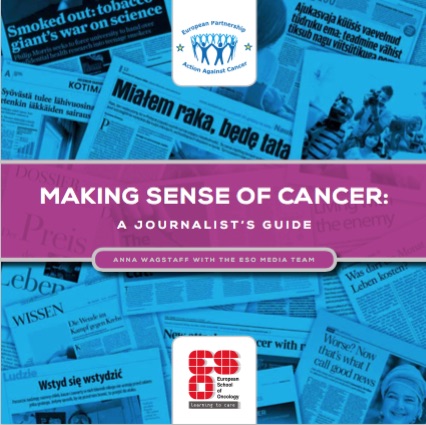Journalist Cancer Guide
ESO organises several initiatives for and with the International media. Here is a list of the most recent and relevant ones.
Making Sense of Cancer – a journalist’s guide
Covering cancer stories is a rich and rewarding area of journalism – but it is also difficult. Drawing on years of experience writing for Cancer World, as well as conducting media training with print and broadcast journalists from all over Europe, the ESO media team have published a Journalist’s Guide to Making Sense of Cancer.
The Guide is aimed at busy journalists who want to help their audiences make sense of stories about individual experiences – good or bad – scientific or quasi-scientific reports and statistical and other studies.
It covers how to evaluate the credibility of a story, how to explain its relevance to their audience, how to interpret and convey statistical information, how to address implications for policy and practice and more. It uses many of the articles that have won Best Cancer Reporter Awards as good examples of how to tackle different topics.
Guide’s contents
• Making sense of cancer • What is cancer? Making sense of the disease • What gives you cancer? Making sense of risk factors • The main risk factors • Advice on lowering risk • Making sense of risk statistics • Population risk or individual risk? • Age: the biggest risk factor • Lifetime risk, or instantaneous risk? • Risk versus benefits Relative risk or excess risk? Evaluating stories about risk • What can be done about it? A critical look at cancer control policies • Prevention • Healthy lifestyles: promoting informed debate • Vested interests: resisting spin • Targeted prevention • Early detection • Awareness attitudes and access • Population screening • Opportunistic screening• Covering screening stories • Who should be screened? Questions about quality • Treatment care and support • Equal access to quality care • Factors in effective treatment • Organisation of services • A multidisciplinary approach • The case of rare cancers • Minimum volumes • Staffing, equipment and drugs • Clinical research • Reporting on the effectiveness of treatment • “Avoidable deaths” • Factors in quality care and support • Psychological support and shared decision making • Managing side-effects • When treatment ends • Supporting people living with cancer • Attitudes in the community • Factors in good governance of healthcare • Guidelines • Guideline compliance • Monitoring performance and outcomes • Patient-reported outcomes • Accreditation systems • Beyond the ‘scandal’: reporting on governance of healthcare • Describing the size of the problem and evaluating progress • Incidence, mortality, prevalence and survival data • Stage of diagnosis • Data coverage • New treatments and discoveries: evaluating and reporting on the evidence • Progress: the story so far • More incremental than breakthrough • Unrealistic expectations • Evaluating claims about new research • Be critical • Beware of ‘presentational bias’ • Where does the report originate? • Ask the “So what?” question • Evaluating and interpreting clinical trials • What is the trial designed to show? • Trial phases • Clinical endpoints • Side-effects and quality of life • Who is being studied? • Types of study • An acceptable level of evidence? • Is it affordable? • Understanding and reporting statistical data • Example: the HERA trial • Interpreting it for your audience • Reporting Herceptin – a case study of hype • Reporting on Complementary or alternative therapies • Look at the evidence • Look at the credentials and vested interest of your sources • ‘Balance’ doesn’t mean everyone is equally credible • What role should non-conventional treatments play? • Questions for mainstream healthcare • Resources
Cancerworld is published by OncoDaily (P53 Inc.) | Mailing Address: 867 Boylston st, 5th floor, Ste 1094 Boston, MA 02116, United States | [email protected]

